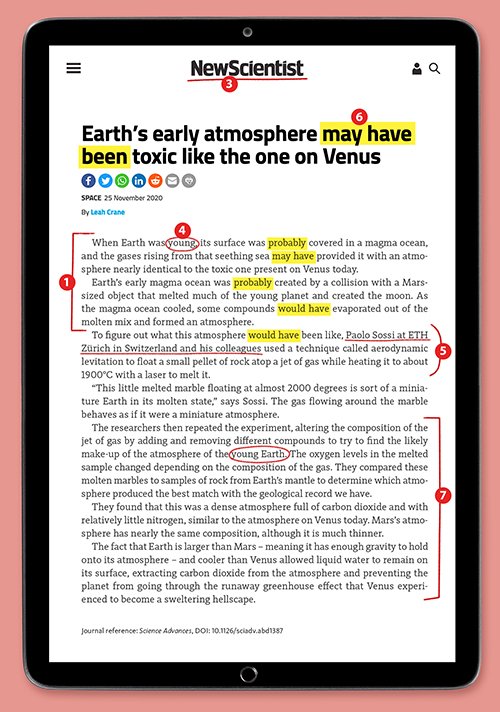Tools for Critical Thinking
Biblical critical thinking skills provide a practical toolset for combatting the culture’s lies.
Maybe you’re scrolling through social media when you read the headline, “Scientists Discover 150-Million-Year-Old Dinosaur Was Evolving Feathers.” Maybe you’re sitting in class when the lecturer remarks, “Religions probably evolved as a means for humans to cope with uncertainty, explain the unexplainable, and exercise social control.” Or maybe you’re listening to a sermon when the preacher declares, “Jesus’ miracles have natural explanations because Jesus was a natural person. After his death, legends emerged around his name, borrowing from pagan folklore.”1
Online, at school, in churches—unbiblical messages are bound to confront us in everyday life. Even though we know that messages that contradict God’s Word are not true, they can still seem incredibly persuasive. They can lure individuals, families, and entire societies away from the foundation of God’s Word to the mire of human reasoning, which says we’re not accountable to a Creator.
To combat culture’s countless lies, Christians need apologetics training to defend their biblical worldview. But no matter how many apologetics answers believers memorize, we’re always bound to encounter more questions because there will always be new information. That’s why Christians must learn how to pursue biblical answers and think like apologists. Believers need an accessible toolset to help them process and deal with faith-challenging information.
Enter Critical Thinking Skills
Biblical critical thinking skills provide that practical toolset. But what is critical thinking, exactly? Growing up, I suspected critical thinking was just a buzzword that educators used for creating assignments. But in college, I learned that critical thinking is about discerning whether messages are true, logical, and worth believing. I suddenly saw critical thinking transform from a scrap of junk jargon into an indispensable lie detection toolkit.
These tools include skills like spotting faulty logic, sensing psychological manipulation, and sorting out facts from opinions, interpretations, or assumptions. By applying these tools from the starting point of God’s Word, Christians can think through faith-challenging messages and reach a biblical, logical response.
Wait—Isn’t Critical Thinking Secular?
Some Christians may be concerned because critical thinking is a concept praised by secularists who promote “rationality.” The word rational means having reason or being reasonable. Critical thinking is rational in the sense that it involves logical reasoning. Secularists, however, may try to incorrectly redefine rational as “excluding God.” This doesn’t mean critical thinking is secular, just that the definition of rational has been manipulated.
Ironically, however, a biblical worldview— not a secular one—provides the foundation for logic, making critical thinking possible.2 We can think critically because God is the source of absolutes. He created a logical universe and gave us faculties for reasoning. Unlike messages that contradict the Bible, God’s Word will always stand up to scrutiny. Ultimately, Christians have no reason to resist critical thinking and every reason to embrace it.
How to Think About “Facts” That Challenge Your Faith
So how can you learn to think critically? Based on the tools that helped me as a Christian in secular university, I developed a framework that explains how to think through any faithchallenging message in classrooms and in the culture. This framework comes down to three rules of critical thinking: don’t panic, break it down, and follow up.
1. Don’t Panic
This one may seem obvious. But if you’re listening to someone making an unbiblical argument you’ve never heard before, you may notice your heart rate increasing. And you may begin to wonder, What if I’m wrong about my beliefs? That’s the time to take a breath and remember what you know: God’s Word is true, so anything contradictory must be false. Every untrue message is certain to fall apart somewhere. Until you have the chance to investigate where it falls apart, here are a couple of tips for warding off anxiety:
- If you’re a student who needs to write down faith-challenging messages when taking lecture notes, put quotation marks around questionable information, indicating that you’re simply noting what somebody said. This frees you from feeling like you’re writing a fact.
- Write down your questions immediately. Keeping a physical record of your questions lets you follow up on them later. Otherwise, you may begin to sense a mass of nameless doubts accumulating without being able to remember, identify, and deal with specific concerns.
2. Break It Down
To find out how the lies in an unbiblical message fall apart, you can dismantle the information with these 7 Checks of Critical Thinking:
Check 1: Check Scripture
How does this message compare with God’s Word?
You can always detect a lie by comparing it to the truth, and God’s Word is our ultimate source for truth. So when you hear any message presented as a fact, compare it against Scripture first to see whether it’s true. You’ll be best equipped to do this if you’re deeply familiar with Scripture. That’s why it’s so important for us as Christians to consistently fill ourselves with God’s Word.
Check 2: Check the Challenge
Does this message challenge a foundational doctrine or a negotiable side issue?
Sometimes as you compare a message against Scripture, you realize it doesn’t challenge your faith so much as your ideas about your faith. Maybe the message confronts your opinions about certain church traditions, worship styles, or some other nondoctrinal issue—like the question of how many magi visited Jesus. Since the Bible doesn’t say, we can conclude it’s a side issue. That’s very different from a doctrinal foundation issue, like the question of Adam’s existence. Jesus came to earth as Adam’s descendant to die because of Adam’s sin, making Adam’s existence a foundational issue. You can recognize challenges to foundation issues by asking, “Does the message conflict with a clear teaching from Scripture? Does it conflict with the big picture of what the Bible teaches? And does it conflict with the way most Christians have interpreted the Bible for thousands of years?”
Check 3: Check the Source
Where is this information coming from, and how was it collected?
Sometimes, valid information comes from unreliable sources, and invalid information comes from reliable sources. Still, a source’s reliability lends insight into how seriously to take a message. Relevant experts typically serve as the most credible human sources. But remember, even experts can make mistakes, believe false information, and exercise bias according to their worldviews.
Another part of checking the source involves asking how information was collected and whether it’s communicated accurately. Popular articles reporting what “studies have shown” don’t always mention details like the number or type of participants involved in a study, the strength of any observed effects, or other factors that can affect how we should interpret the studies’ results. Such articles may also draw sensational conclusions beyond a study’s claims. That’s why it’s important to check the original research yourself.3
Check 4: Check the Definitions
What do the message’s keywords mean?
Do their meanings change? Now it’s time to clarify the definitions of keywords in the message. Many words harbor multiple meanings or mean different things to different people. When I encounter words such as science, evolution, and even Christianity, I find it helpful to consider how those terms are being used and whether their meanings subtly change. For instance, does an example of evolution refer to “variation within a created kind” (which is actually a biblical concept) or “transformation between created kinds” (the traditional evolutionary assertion)? If you notice a change in a keyword’s meaning, you’ve detected a logical fallacy called equivocation.
Check 5: Check for Propaganda
Why does this message sound persuasive?
Propaganda is a manipulative form of communication that tries to persuade using any means besides logic. Instead of reasoning from facts, propaganda relies on factors like emotion, aesthetics, eloquence, authority, positive or negative associations, repetition, or ridicule. Propaganda-based arguments usually involve logical errors called fallacies of irrelevant premises. You can catch an irrelevant premise by asking, “Is this message true or false because. . . ?” For example, is a message true because many people believe it or because someone intelligent said so? Not necessarily.4
Check 6: Check the Interpretations
Which parts of this message are facts and which are assumptions?
Is there another way to view the facts? With propaganda removed, you should be left with only facts and their interpretations. This is where observational science and historical science come in. The facts are the parts of the message involving observational science, which measures and describes things in the present. For example, we could use observational science to perform experiments in a laboratory, identify fossil species, or analyze fingerprints from a crime scene. The historical science in a message, however, draws conclusions about the past based on interpretations of facts in the present.
Guessing how a fossil formed or reconstructing what we think happened at a crime scene would be historical science. Red flag words like could, might, maybe, probably, possibly, and may signal you’re dealing with possible interpretations from historical science rather than definite facts from observational science. To identify alternative explanations, think about ways to interpret the same facts from a biblical perspective.
Check 7: Check the Logic
Are there any other logical errors that should make me think twice about this message?
By now, you will have spotted many potential fallacies in a message. But other lines of faulty logic may still lurk behind the facts. For instance, straw man arguments reframe an opposing viewpoint to make it seem weaker than it is. Circular arguments presuppose the truth of the conclusions they’re trying to prove. Faulty analogies say two things are alike when there’s an important difference between them. Executing a final scan for such errors ensures you don’t fall for any lingering fallacies.
3. Follow Up
Faith crises don’t happen when Christians begin asking questions. They happen when we stop seeking answers. Having questions means that we must carefully research and seek answers from sound apologetics resources, biblical mentors, and God himself.
Even after careful critical thinking, however, you’ll likely still have some unresolved questions about certain topics.
But faith crises don’t happen when Christians begin asking questions. They happen when we stop seeking answers. Having questions means that we must carefully research and seek answers from sound apologetics resources, biblical mentors, and God himself.
Instead of panicking about questions that may still remain, remember Peter’s response when Jesus asked if the disciples wanted to leave after his teachings became tough: “Simon Peter answered him, ‘Lord, to whom shall we go? You have the words of eternal life, and we have believed, and have come to know, that you are the Holy One of God’” (John 6:68–69).
These words encouraged me throughout university, reminding me that the evidence for my faith far outweighed the uncertainty of my unresolved questions. As humans, we’ll never understand everything. The key is to remember that God has the answer, to ask him for it, and to trust our concerns to him even if he never reveals the answers while we’re here on earth.
Armed and Ready
The next time you encounter a message that contradicts Scripture, remember the three critical thinking rules: don’t panic, break the message down with the 7 Checks of Critical Thinking, and follow up on remaining questions. I encourage you to keep honing these tools and flexing your mental muscles until biblical critical thinking becomes second nature. Then, whether scrolling on social media, sitting in class, or listening to a sermon, you’ll be ready to think through any faith-challenging message and arrive at a biblical, logical conclusion yourself.
Critical Thinking in Action
Check out this example of using the 7 Checks of Critical Thinking to evaluate an actual news article.

Click image to enlarge.
Check 1: Check Scripture
The Bible doesn’t tell us many details about earth’s earliest atmosphere, but we can infer that it supported plant life by day three. The magma ocean and moon formation scenarios in the article don’t appear to align with the Genesis creation account or with the teaching that “the earth was formed out of water and through water by the word of God” (2 Peter 3:5).
Check 2: Check the Challenge
Accepting any teachings in the article that conflict with God’s Word would pose a biblical authority issue. Also, while the article does not state specific assumptions about earth’s age, its naturalistic approach implies belief in millions of years, which challenges Scripture’s doctrine of no death before sin.
Check 3: Check the Source
Because of the article's apparent naturalistic starting point, we can infer that the author and the researchers quoted are beginning from the worldview of man’s word rather than God’s Word. This will affect their assumptions and interpretations of facts (remember this for Check 6).
Check 4: Check the Definitions
No words seem to switch meanings in this article. One term that may need clarification for further discussion is “young Earth,” as biblical creationists and evolutionists have very different ideas about when earth was “young.” As noted above, however, it’s safe to presume the article means “young” as “happening 4.5 billion years ago.”
Check 5: Check for Propaganda
Some fancy, intellectual-sounding words start coming into play here, which is fine—even necessary. The resulting “sciency” feel can make the rest of the article’s teaching sound true. But remember to ask, “Is a message true because . . . it comes from intelligent researchers who performed a high-tech experiment?” Not necessarily.
Check 6: Check the Interpretations
What was the observational science in this experiment? The facts that we can see in the present include all the measurements and observations made in the lab, along with observations about how earth currently compares to Venus. All the assumptions about earth’s early conditions which formed the basis of the experiment, however, were evolutionary historical science—as signaled by the red flag words such as “probably,” “may have,” and “would have.”
Check 7: Check the Logic
Fallacies would come into play if someone argued that this experiment “proved” the existence of a magma ocean 4.5 billion years ago. For instance, arguing, “If a magma ocean existed 4.5 billion years ago, then oxygen levels in earth’s mantle would match those of marbles melted in the presence of high CO2. They do. Therefore, a magma ocean must have existed 4.5 billion years ago.” However, there could be other reasons for the CO2 levels in earth’s mantle. This is a fallacy “affirming the consequent.”
Footnotes
- You can find answers to these and other objections at AnswersInGenesis.org and Answers.tv.
- For why a secular worldview does not provide a basis for truth, knowledge, and logic, see Lisle, Jason. The Ultimate Proof of Creation: Resolving the Origins Debate. New Leaf Publishing Group, 2009.
- See my Answers TV show CT Scan Season 1, Episode 100 for how to find and read scientific studies.
- See my Answers TV show CT Scan Season 1, Episode 13 for more information.
Recommended Resources

Answers in Genesis is an apologetics ministry, dedicated to helping Christians defend their faith and proclaim the good news of Jesus Christ.
- Customer Service 800.778.3390
- Available Monday–Friday | 9 AM–5 PM ET
- © 2025 Answers in Genesis




